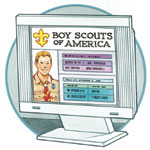
News Briefs
There's still time to enter Scouting magazine's Cartoon Caption Contest
Readers have until Oct. 1 to enter Scouting magazine's Cartoon Caption Contest—and win as much as $400 in BSA Supply Group gift certificates.
The contest is open to all registered BSA members, youth and adult. Submit captions for any or all of four cartoons which were shown in the May-June 2006 issue. The four cartoons and rules for entering are also available at www.scoutingmagazine.org/issues/current/a-entr.html, where it is possible to submit entries online.
Individuals submitting the winning captions for each cartoon, which will be published in the March-April 2007 issue of Scouting, will receive BSA Supply Group gift certificates in the following amounts: 1st Place—$100; 2nd Place—$75; 3rd Place—$50.
Internet program allows leaders to record member advancement
More than 220 BSA councils using Internet Rechartering will now offer Internet Advancement, a new online service for units to enter and track the official advancement record for each youth member.
Unit volunteers will record unit member advancement information online, which will simplify the process of preparing unit advancement reports and reduce the time it takes the council to manage this information.
Since each unit is responsible for approving and tracking the advancement of its members, the data entered into the system will be complete and accurate. Only the Eagle Scout rank cannot be recorded by this process.
Units can upload data directly from unit management software, such as PackMaster and TroopMaster. Additional Cub Scout advancements, including Webelos activity badges, can also be recorded.
A monthly submission of unit advancements is suggested. Also, in December each unit should submit any advancement not yet recorded so that unit and council statistics can be updated for the entire year.
Several reports are available to units using the program:
- The Advancement Report Package is printed after each submittal and shows new ranks, merit badges, and awards, summarized by type and quantity earned, and lists changes in previously recorded data.
- A Unit Advancement Summary lists advancements earned by unit members that are appropriate to their unit type.
- The Unit Roster lists the current adult and youth unit members.
Councils will provide instructions on the council Web site and training for leaders and others, answer questions, and provide guidelines, procedures, and directions for gaining online access.
Check council Web sites for information about using Internet Advancement.
'Race to Cub Scouting' Continues in 2006
As the fall recruiting season looms for Cub Scout packs across America, thousands of volunteer leaders are asking the question: "How do you win the 'Race to Cub Scouting'?"
The answer: time-tested basics combined with the fresh, new approaches featured in the "Race to Cub Scouting" promotional program, according to Chuck Herrera, director of field service for the North Florida Council. In 2005, that formula helped the Jacksonville-based council boost its Cub Scout membership by a robust 2.5 percent.
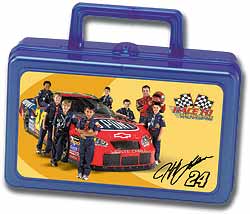
Aided by TV spots featuring NASCAR racing champion Jeff Gordon, the national "Race to Cub Scouting" campaign was launched in 2005, using new recruiting materials including a special pinewood derby kit given to each prospective Cub Scout. Last year nearly three out of four BSA councils used a "Race to Cub Scouting" theme for their recruiting campaign.
For 2006, the NASCAR theme continues, with each boy who attends a school night program receiving a sturdy plastic "lunchbox" containing a miniature racing car packaged with an autographed photo of Gordon.
"The great new race-theme materials developed by the BSA are the best recruiting tools I've seen in many years, and they've helped in a lot of ways," says Herrera. "But nothing can replace the time-tested recruiting fundamentals, like making an in-class pitch to the kids, holding an actual school night program, and, most important, doing solid planning and organization beforehand."
"Race-theme promotional materials are available in all councils," says Samuel Thompson, national director of Cub Scouting, "and the program is being used by 249 councils. Nationally, records show that councils that use the program are recruiting more successfully than those that don't."
And winning the race still takes plenty of work and advance preparation, Herrera emphasizes. "If we're serious about making Scouting a part of a boy's life, we've got to live the planning," he says.
"Fortunately, we have an awesome team of volunteers in our council who are willing to do that. But it's also important to change the approach somewhat each year to give it some 'sizzle.'"
So start your engines! The big race is on—again!
—Bill Sloan
Troop's TV Crew Chronicles—And Makes—History
For most viewers, community-access cable TV programming is often lost amid a mind-boggling array of channel choices. But in Hatboro, Pa., an outlying suburb of Philadelphia, community-access Channel 22 is among the hottest media tickets in town—thanks to VT3-22, a hardworking television production team from local Scout Troop 3, chartered to the Hatboro Baptist Church.
For five years, VT3-22's young reporters, cameramen, announcers, and producers have been chronicling the day-to-day history of Hatboro, covering events ranging from a tropical storm to parades, air shows to high school sports, and then packaging them for viewing on Channel 22.
In the process, they've made some history themselves, says Scoutmaster Robert M. John, by creating a model community service program with special appeal for older Boy Scouts that other troops in other small communities could easily follow.
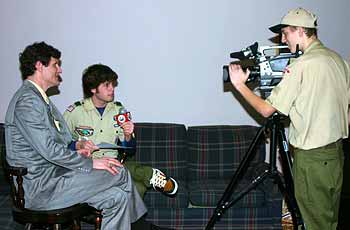 Scouts Chris Burrell (left) and Shawn Allard record an interview with a borough council member. Photograph Courtesy of Hatboro Troop 3 |
"Like most Scoutmasters, I'm always looking for ways to make our program more relative, exciting, and interesting for all our Scouts," John explains.
"Since we're a traditional Boy Scout troop with a membership of about 75 boys ranging from 11 to 18, this means providing challenging activities for a broad age group. Troops that don't offer advanced programs for their older boys simply don't retain a lot of them."
Most Scouts who fill VT3-22's more technical and demanding jobs are 14 years old or older members of the troop's Venture patrol. But many younger Scouts also participate in the TV productions, handling such duties as moving and setting up equipment, relaying messages, and assisting interviewees.
The VT3-22 team got its start in early 2001 after the borough received a video camcorder through a grant and the Hatboro Rotary Club donated a digital camera. When John, a local attorney, approached the borough council with the idea of putting together a Boy Scout video team to use the equipment, he received enthusiastic approval.
"Many smaller communities don't realize that federal law requires cable companies to provide community-access channels where they are wanted," John notes. "What we've done could be duplicated by practically any Scout troop. All you really need to start is a good video camera costing around $200 and access to a computer to scan in still photos and video clips."
VT3-22 now produces about 40 shows per year and has steadily branched out into new areas of coverage. As an Eagle Scout service project, one Scout supervised the laying of 1,000 feet of cable that connected four cameras to televise local games at the high school football stadium.
The TV crew also sponsored a "Meet the Candidates Night" during a recent election campaign, employing younger Scouts to greet arriving office-seekers, advise them of the program's format, and time their answers to on-camera questions.
"This project provides merit badge opportunities in many fields, including cinematography, journalism, public speaking, photography, computer science, and others," John points out.
VT3-22 has also proved to be a tremendous asset in promoting Scouting in the community, adds Scout Executive William T. Dwyer III of the Cradle of Liberty Council. That is because many of the shows produced by the TV team feature BSA activities.
"Anytime you get a successful media marketing tool like this, it can't help but be great for Scouting," Dwyer emphasizes.
— Bill Sloan
Leaders and youth bring Scouting to families in unusual locations
Dedication and determination on behalf of Scouts and Scouters is bringing the BSA's programs to places one normally would not expect to see a Cub Scout or a Boy Scout.
Three examples:
• In 2000, 12-year-old Scout Greg Sweeney was working on his brother's Eagle Scout service project by reading to youngsters with no permanent addresses at a Wilmington, Del., day-care center. That is when he came up with the idea for a Cub Scout pack for homeless boys.
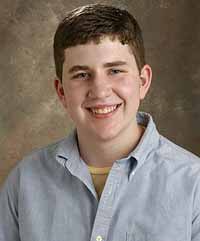 As a 12-year-old Boy Scout, Greg Sweeney (above) started Cub Scout Pack 506 for homeless boys (below) in Wilmington, Del., earning his Eagle Scout Award along the way. Photographs Courtesy of Robert Long and Kathy Canavan 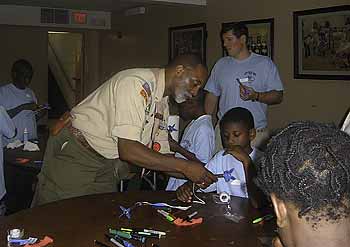
|
"A social worker complimented us on being good role models for these boys, and I thought how neat it would be to set up a Cub Scout pack for them," recalls Greg, now 18 and a freshman at the University of Delaware. "I wasn't sure I could do it because I was so young, but I knew it would be great for the kids."
With help from Wilmington's Ministry of Caring, at which he was a volunteer, Greg got Pack 506 up and running soon after his 13th birthday. It has since served scores of boys living in shelters, condemned buildings, even cars, while maintaining an active membership of about 15. For five years, Greg functioned as a sort of "big brother" to the pack, raising money for uniforms, planning meetings, organizing field trips—and earning his own Eagle Scout badge along the way.
"Some kids were able to get out of the shelters and go into regular packs and troops," he says. "I still stay in touch with them as much as I can."
Last December, in recognition of his bright idea and hard work, Greg was voted into the Hall of Fame of Caring Americans by the Caring Institute, whose honorary board of trustees is chaired by former U.S. Senator Bob Dole.
"We'd been trying for years to get something like this started," says an impressed Janice Payne, director of strategic initiatives for the Del-Mar-Va Council. "Then here comes a 12-year-old who does it practically by himself!"
• Across the continent at Purdy, Wash., a women's prison is the unlikely location and chartered organization for a troop and pack that comprises sons of incarcerated mothers.
Pack 60 and Troop 60, chartered to the Purdy Correctional Facility, are a special facet of the Chief Seattle Council's Scoutreach program, which founded and provides staffing for both units.
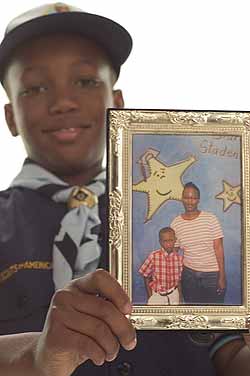 Dewaine Stewart and his mother attend Pack 60 meetings together. Photograph Courtesy of Chief Seattle Council |
"It started as an initiative of our council, but we provide program support to youth throughout all of western Washington," says Seattle director of support services Alicia Lifrak. "We also collaborate with a Girl Scout unit at Purdy."
To attend monthly meetings, the 15 members of the pack and troop must be transported by van from their homes, which are located over a widely scattered area.
The Scouts' mothers are serving sentences for offenses ranging from forgery to manslaughter.
Nevertheless, "these women take an active role in planning meetings and presenting programs," Lifrak says, "the same as mothers of [any other] Scouts; and they show the same kind of pride when their sons earn advancement and merit badges."
The troop and pack provide two key services. If not for the program, most Scouts might not see their mothers at all during their incarceration. And many would have no other access to Scouting, Lifrak explains.
Odds that children in these circumstances will end up in prison as adults are six to seven times higher than average.
"I hope we can reduce those odds," says Lifrak. "It's vital for these boys to get support from each other, to have contact with their moms, and to see firsthand that prison is no picnic."
• And in Providence, R.I., Troop 888 represents yet another example of exceptional service and dedication by a local BSA volunteer.
Launched in 2002 through the efforts of Scouter Pat Dochety, Troop 888 is based at a Gospel Rescue Mission and serves disadvantaged inner-city youth. To serve as an anchoring partner for the new troop, Dochety enlisted the efforts of Troop 8 of Cranston, R.I., where he serves as committee chairman.
Sean Carew, executive director of the Providence Rescue Mission, deals daily with drug addicts, prostitutes, mental patients, and the homeless poor. He sees the devastating impact on inner-city youth and calls the Scouting results "exciting."
"If these kids aren't reached while they're young, they're likely to become the kind of adults we have to minister to later on," Carew says.
The more the mission works with the urban poor, the more Carew realizes that the children it serves often are denied the chance to develop positive values, sound goals, and the ability to contribute positively to society—"the same qualities," Carew notes, "emphasized in Scouting."
With Troop 8 providing funds, equipment, and leadership—including that of Dochety's Eagle Scout son, Pat Jr., who served as Troop 888 Scoutmaster for a year—the inner-city unit holds weekly meetings, goes on monthly camp-outs, attends summer camp, and takes canoeing, skiing, and hiking trips.
The local Narragansett Council's effort to form an inner-city troop at the mission a decade ago failed, Dochety says, because of a lack of available leadership. "This time, thanks to the support of the local Narragansett Council, the Providence Rescue Mission, and help from Soutmaster Mike DeLuca of Troop 8, we were able to put it all together."
To date, more than 40 boys have been members of Troop 888. "It has clearly made a difference in their lives," Dochety notes. "Some who were on their way to joining gangs have become Scouts instead; two are Star Scouts now and on the track to Eagle."
And Troop 888 has made a believer out of rescue mission director Carew. "Because of our success here," he says, "we strongly recommend that other gospel missions establish Scouting programs to serve inner-city kids."
— Bill Sloan
Numbers
3—ways Cub Scouts, Boy Scouts, and Venturers in the York- Adams Area Council (York, Pa.) are participating in councilwide programs for the BSA's Good Turn for America, which highlights the issues of hunger, health, and shelter. Last November, 64,462 food items were collected in the council's annual Scouting for Food campaign. In January, for a blood drive conducted with the American Red Cross, 503 Scouts recruited 862 donors, reminded them of appointment times, and helped out at 20 donation sites. (The blood was enough to help more than 2,900 hospital patients and represented an 81 percent increase over the first councilwide drive in 2005.) In April, 382 Scouts collected more than 6,718 items to support a variety of community shelter programs.
75—years of Scouting activity achieved by George Kaufman, 88, Manitowoc, Wis., in 2006. Kaufman, who became a Scout in 1931, currently serves as an advisory board member and on his district Eagle board of review. In March he was honored as the Bay-Lakes Council's oldest living continuously registered Eagle Scout at the council awards dinner.
50—years that Pack 61, chartered to the St. Paul United Church of Christ in New Bremen, Ohio, in the Black Swamp Area Council (Findlay, Ohio) has held an annual pinewood derby. In January the pack noted the anniversary with a special celebration attended by some of the former Cub Scouts who took part in the first pack derby in 1956.
150—Eagle Scouts from the class of 2005 honored at the Baltimore Area Council's annual recognition dinner last January. Also honored were 17 Scouters who received the Silver Beaver Award for distinguished service to youth within a council. Keynote speaker for the evening was Dr. Peter Agre, winner of the 2003 Nobel Prize in Chemistry and until recently a longtime assistant Scoutmaster with Troop 35, chartered to the Episcopal Church of the Redeemer in Baltimore.
CORRECTION In the May-June issue of Scouting, the assistant Scoutmaster on the cover was misidentified. The photograph shows Dave Hutchinson leading Scouts of Troop 474 from Kent, Wash., to the summit of Mount Rainier.
New Quality Award changes are in effect for 2006
Several criteria changes have been made in 2006 for unit, district, and council Quality awards, the annual recognitions for meeting national standards for leader training, service, advancement, camping, and membership growth.
For the Quality Unit Award, objective No. 6 (for troops and teams) and No. 7 (for packs and crews) now reads: "Service Project. [Our unit] will conduct an annual service project, preferably for the chartered organization or the community. We will report our project on the www.goodturnforamerica.org Web site."
For district and council Quality awards, objective No. 9 now reads: "Reregister at least 70 percent of youth members or reregister at least 50 percent with an increase over last year."
Quality Unit Award applications for 2006 are available at local Scout council service centers, from unit commissioners, or can be downloaded from www.scouting.org/forms.
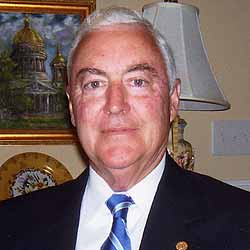 Walter M. (Buster) Brown Photograph Courtesy of Walter M. Brown |
North Carolina Scouter is recognized for service to youth with disabilities
Walter M. (Buster) Brown, Elon, N.C., is the 2006 recipient of the Woods Services Award, presented by the BSA and the Woods Services and Residential Treatment Center, Langhorne, Pa., for exceptional service and leadership to Scouts with disabilities.
Brown's involvement with Scouting began in 1959 with the local district special needs committee. Since then, he has impacted the lives of thousands of youth with disabilities by serving in a variety of positions on the district, council, area, region, and national levels.
At the national level, Brown served as chairman of the BSA's National Special Needs Committee, assisting in updating reference materials and adding additional tools to help volunteers support programs for youth with disabilities. His efforts have helped to insure that the needs of these youth are a part of BSA literature, facilities, and program.
Brown's Scouting involvement also has been recognized with the Distinguished Commissioner award, the District Award of Merit, the Silver Beaver, and the Silver Antelope award.
Composite Materials is the BSA's newest merit badge
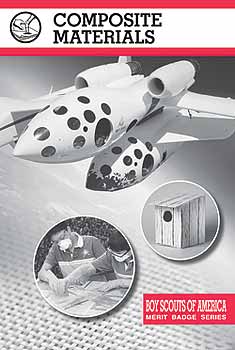
The type of materials used in the manufacture of canoes, kayaks, golf clubs, aircraft, refrigerators, and many other products is the subject of Composite Materials, the BSA's newest merit badge.
Modern composites help make products stronger and more durable, lightweight, rustproof, and resistant to heat, cold, and humidity.
Scouts earning the merit badge will learn about an industry offering a wide range of career opportunities, as well as how composites are made and how they differ from conventional building materials, such as wood, aluminum, copper, and steel.
Requirements also include using composite materials to build two projects. The M.C. Gill Corporation, a composites manufacturer in the commercial aircraft and aerospace industries, funded development of the merit badge as well as the Composite Materials merit badge pamphlet (BSA No. 33252).
The American Composites Manufacturers Association (ACMA) also assisted in the development of the badge and may be tapped as a resource by local councils to provide merit badge counselors. Visit the ACMA Web site, www.acmanet.org, for more information.
The American Legion Eagle Scout of the Year
Nicholas Peter Coury, 18, a Scout in Troop 262, Glendale, Ariz., is the American Legion Eagle Scout of the Year for 2006.
The award includes a $10,000 college scholarship and recognizes Nicholas's involvement in school, religious, and community service projects.
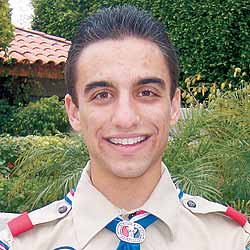 Nicholas Peter Coury Photograph Courtesy of The American Legion |
Wanting to give back something to his grade school for nurturing his academic interests, Nicholas designed and built a reading loft for the kindergarten class at Marshall Ranch Elementary as his Eagle Scout project, providing a fun learning environment for many youngsters.
Scout leaders, clergy, and teachers attest to Nicholas's leadership abilities and his desire to serve, whether in his church's youth ministry, in the Glendale Community Volunteer Program, or in school activities, including high school cross country and track and field. Nicholas was also selected to participate on the City of Glendale Mayor's Youth Advisory Commission, which meets monthly with Mayor Elaine Scruggs.
An Eagle Scout since 2005, Nicholas achieved a 4.0 academic average in high school and now attends Arizona State University, pursuing a double degree in math and science.
The American Legion also awarded a $2,500 scholarship to Paul E. Martin, Troop 168, Martinsville, Va.; Matthew Adams Abee, Troop 396 and Crew 396, Murrells Inlet, S.C.; and Tony C. Tillman II, Troop 75, Leesville, La.
The American Legion has supported Scouting since the veterans' group's first national convention in 1919. Legion posts serve as chartered organizations for more than 2,700 Scouting units, serving more than 72,000 youth.
September 2006 Table of Contents
Copyright © 2006 by the Boy Scouts of America. All rights thereunder reserved; anything appearing in Scouting magazine or on its Web site may not be reprinted either wholly or in part without written permission. Because of freedom given authors, opinions may not reflect official concurrence.